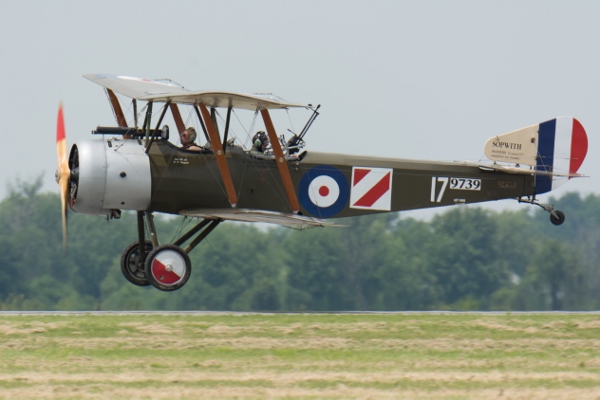
|
 |
Sopwith 1½ Strutter |
 |
 |
 |
 |
 |
|---|---|---|---|---|---|---|---|
 |
 |
 |
 |
 |
|||
| It was a trim single-bay biplane with wings of equal spans and both upper and lower wings were constructed of two sections. It was conventional in design of wire braced wood and fabric construction. The airplane had a variable incidence tailplane that could be trimmed in flight by the pilot and flaps were installed to decrease airspeed for landing. The center section struts consisted of steel tubes which were half the size of the outboard struts. The cockpits were in tandem and widely apart with the pilot sitting in front and the gunner in the aft cockpit with a wide field of fire. |
|
Because of a shortage of the interrupter gears for the machine gun synchronization, early aircraft were delivered with only a Lewis machine gun in the aft cockpit. The bomber version had the aft cockpit closed to carry extra fuel and bombs.
As with other early Sopwiths, the structure was lightly built and not very durable as a military aircraft. It was too stable to be a good dogfighter and the distance between cockpits hindered communication between the pilot and gunner. They were replaced as frontline aircraft with Sopwith Camels in October 1917. |
| Specifications: | |
|---|---|
| Sopwith 1½ Strutter | |
| Dimensions: | |
| Wing span: | 33 ft 6 in (10.21 m) |
| Length: | 25 ft 3 in (7.70 m) |
| Height: | 10 ft 3 in (3.12 m) |
| Weights: | |
| Empty: | 1,305 lb (593 kg) |
| Loaded Weight: | 2,149 lb (975 kg) |
| Performance: | |
| Maximum Speed: | 100 mph (161 km/h) at 6,500 ft (1,980 m) |
| Rate of Climb: | 9 min 10 s to 6,500 ft. (1,980 m) |
| Endurance: | 3¾ hours |
| Powerplant: | |
| One 130 hp (97 kW) Clerget air-cooled rotary engine. | |
| Armament: | |
|
One forward firing Vickers 0.303 caliber (7.7 mm) synchronized machine gun. One Lewis .303 caliber (7.7 mm) gun in observer's cockpit. | |
©Larry Dwyer. The Aviation History Online Museum.
All rights reserved.
Created November 11, 1997. Updated November 30, 2013.
